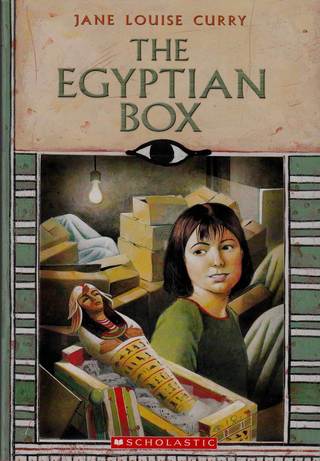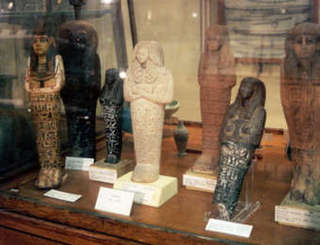The Egyptian Box

An eleven-year-old girl and her nerdy little brother take on an ancient magic-- and lose.
Or maybe not…
If you inherited a "magical servant," a two-and-a-half-thousand-or-so year-old painted wooden figure from your weird Great-Uncle Sebastian, and your little brother Charles accidentally (and unknowingly) brings it to life, what would you do? Keep it a secret? Well, yes. But then? When day by day it comes more to look like you—and even learns English—how could you not think, "This could be huge!" And how could you not try, say, sending it to school in your place? What could go wrong?
In a word, everything. Dead wrong.
The "doll" in the ancient Egyptian box that Great-Uncle Sebastian leaves to young Leticia ("Tee") Woodie is no doll, but a shabti, a wooden tomb figure meant to be a magical servant in the Afterlife to the Princess Tiye it was buried with. And this shabti is sharp. And it learns fast. Once out of its cramped little box, it soon twigs that Tee is is not Tiye, and this is no Land of the Dead, but a strange, shiny new world it likes. So, it narrows its eyes and goes for it. Tee is about to be Toast.
But-- it's forgotten brainy little Charles...
Behind the Story...

This is a photo I took of one of the shabti cases in the Petrie Museum of Egyptian Archaeology in London. The Petrie Museum has one thousand, six hundred and ninety-six shabtis! When I saw the one at the far left, I knew that was exactly what Tee's magical servant would look like.
Many times when I've been in the British Museum in London, I've made a detour through the Egyptian mummy rooms, both to see the mummies in their brightly decorated coffins, and to enjoy the crowds of schoolchildren buzzing around them in fascination. Once, when the rooms were closed and later re-opened with new cases and newly-arranged displays. I had seen the posters announcing this, but it was weeks later when I suddenly thought, in the middle of doing something else, "I need to go take a look at the new Egyptian Rooms!"
The very first thing 'new' that I spied was a wall case full of familiar-looking shabtis, with an explanation of the magical powers they were supposed to have-- something I hadn't known before. I knew at once that the seed for a story had been planted, and when I saw the brightly-colored shabti boxes, I knew that the title was going to be The Egyptian Box. So I set out to learn more...
The Shabti
A shabti (sometimes named shawabti or ushabti) is a figure of wood, stone, or faience, usually five to eight inches tall, in the form of a person wrapped mummy-fashion from the waist down. Shabtis were placed in tombs so that when the shabti spell was spoken they would follow the dead person into the Afterlife and serve him or her there.
At first, beginning in the time of the Middle Kingdom, shabtis were provided only for the pharaohs, but in time the fashion of having shabtis became popular, and they were placed in the tombs of nobles and commoners as well. In his time in this world, every Egyptian, even the noble and the rich were required by Pharaoh’s law to provide their labor for such yearly duties as plowing and sowing the fields or keeping the irrigation systems in good repair, and they sent their laborers to do the work in their places. Since they believed that the Afterlife was much like this life, they expected that the same demand for labor would be required of them.
The shabti spell was written either on the shabti’s mummy wrappings or on an inner wall of the coffin and it was meant, when spoken aloud, to “activate” the magical shabti-servant—to order it to perform all of the tasks assigned to to its master. The shabti which Tee Woodie finds in her shabti box has its spell written on its mummy wrappings, and that spell translates as:
Oh, this shabti,
If Princess Tiye is detailed
for any work that is to be done yonder in
the netherworld,
or an unpleasant task is imposed upon her
there,
Here I am, you shall say.
If you are detailed
at any time to serve there,
Here I am, you shall say.
Tee’s shabti, from the tomb of an Eighteenth Dynasty Princess Tiye, is, so to speak, “switched on” by Charles's recitation of the spell.
What the Reviews Say
"It's a classic kids' fantasy.... an intriguing story that works on several levels. There's plenty of suspense and mystery for action fans, as well as facts for budding Egyptologists." --BOOKLIST
"I enjoyed this fast-paced book. The author puts you inside the head of Tee Woodie so you can grasp what she thinks and feels. The book has a wonderful ending that leaves readers satisfied. --Sixth-grader Claire F., in the GRAND RAPIDS PRESS
5.0 out of 5 stars. This is a really funny book-- with some cool spooky bits. Fifth-grader Tee Woodie inherits from her oddball great-uncle a box containing an Ancient Egyptian "shabti" doll, made to be the magical servant of "Tiye," the Egyptian princess it was buried with-- and the shabti accidentally gets activated. At first it thinks Tee is the princess, and Tee grabs at the chance to use her magical servant as a double who can go to school for her while she goofs off. You know this has got to backfire, but the surprise-- and the spooky part-- is in how it backfires, and you're really kept guessing how Tee is ever going to outwit her magical double and save herself. --Amazon customer